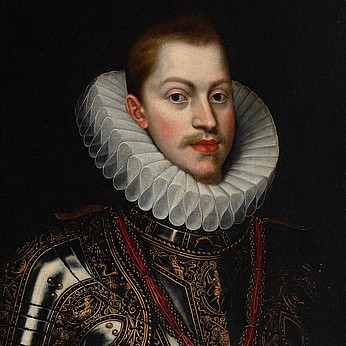VICENTE LÓPEZ PORTAÑA (Valencia, 1772 - Madrid, 1850). "The mystical nuptials of St. Catherine of Siena". Oil on canvas. Relined.
Lot 85
About Seller
Setdart Auction House
Carrer Aragó 346
Barcelona
Spain
Setdart Subastas was born in 2004 and is currently the first online art auction in Spain with solidity, prestige and reliability guaranteed by our more than 60,000 users. Setdart has a young, dynamic and enterprising team ready to successfully manage the purchase and sale of art works through custom...Read more
Estimate:
EUR€9,000 - EUR€10,000
$9,677.42 - $10,752.69
Absentee vs Live bid
Two ways to bid:
- Leave a max absentee bid and the platform will bid on your behalf up to your maximum bid during the live auction.
- Bid live during the auction and your bids will be submitted real-time to the auctioneer.
Bid Increments
| Price | Bid Increment |
|---|---|
| EUR€0 | EUR€10 |
| EUR€200 | EUR€25 |
| EUR€500 | EUR€50 |
| EUR€1,000 | EUR€100 |
| EUR€3,000 | EUR€200 |
| EUR€5,000 | EUR€500 |
| EUR€10,000 | EUR€1,000 |
| EUR€20,000 | EUR€2,000 |
| EUR€50,000 | EUR€5,000 |
About Auction
By Setdart Auction House
Nov 24, 2021
Set Reminder
2021-11-24 09:00:00
2021-11-24 09:00:00
America/New_York
Bidsquare
Bidsquare : Old Masters, Day 1
https://www.bidsquare.com/auctions/setdart-auction-house/old-masters-day-1-7873
Setdart Auction House sofia@setdart.com
Setdart Auction House sofia@setdart.com
- Lot Description
VICENTE LÓPEZ PORTAÑA (Valencia, 1772 - Madrid, 1850). "The mystical nuptials of St. Catherine of Siena". Oil on canvas. Relined. Presents repainting, restorations and period frame made of wood. Measurements: 143 x 93 cm; 155 x 105 cm (frame). Kneeling, adopting a devotional gesture, St. Catherine holds the crown of thorns, while raising her gaze towards the figure of Christ. Jesus, standing, looks at the martyr, while showing her the wounds left by the nails, which on canvas are arranged on a tray. An angel closes the composition, located in the background, a resource that was used in many of the paintings by López Portaña, as can be seen in the dream of St. Joseph, or St. Peter freed by the Angel, both belonging to the collection of the Prado Museum in Madrid. Saint Catherine was born in Siena around 1347, she was the twenty-fifth daughter of a dyer named Jacopo Benincasa. At the age of seven she took a vow of virginity. As her mother wanted to marry her off, she shaved her head. Received into the Third Order of St. Dominic at the age of sixteen, despite family opposition, she wore the black habit of the Tertiaries or Sisters of Penance. In the convent she led an ascetic life that ruined her fragile health. She professed a particular devotion to St. Agnes of Montepulciano. According to legend, when Catherine visited the tomb of St. Agnes, and was bending over the body of the saint to kiss her foot, the saint raised it to the height of her lips. She was glorified for having contributed to bring Pope Gregory XI to Rome from Avignon. On the occasion of the Western Schism, she took the side of Urban VI. She died in Rome in 1380 and was canonized in 1461. Her body rests under the high altar of the Dominican church of Santa Maria sopra Minerva, near Fra Angelico. But her head was claimed by Siena, her hometown. Vicente López began his training as a disciple of Antonio de Villanueva at the Academy of San Carlos in Valencia, where he obtained in 1786 and 1789 the first class prize, obtaining a pension to study in Madrid. Already in the court, the following year he reached the first place in the competition of the Academy of San Fernando. There he learned the baroque and colorful sense of compositions, and the taste for drawing, precise and analytical. The baroque lavishness of the frescoes of Luca Giordano and Corrado Giaquinto also had a decisive influence on his language. Already consecrated, he returned to his native city in 1792. There he received important public and private commissions, including portraits of Ferdinand VII and Marshal Soult. In his portraits López shows his Valencian heritage, the weight of Ribera and Ribalta's naturalism, as well as his mastery in the reproduction of details and qualities. His quality in the field of the portrait makes Fernando VII call him back to the court in 1814, appointing him the following year as first chamber painter. From then on he was the most sought-after painter by the Spanish high society, and he alternated his work at the court with teaching, official posts and private commissions. In 1823 he became the artistic director of the Royal Museum of Paintings, for which he painted a superb portrait of Francisco de Goya, now in the Prado. Works by Vicente López are kept in the Prado Museum, the Fine Arts Museum of Valencia San Pío V, the Academy of San Fernando, the Municipal Museum of Játiva, the National Museum of Art of Catalonia, the New York Historical Society, the Indianapolis Museum of Art, the J. Paul Getty Museum in Los Angeles, the National Gallery of Modern and Contemporary Art in Rome and the Lázaro Galdiano Foundation in Madrid.
- Shipping Info
-
In-house shipping available. Please inquire at admin@setdart.com.
-
- Buyer's Premium



 EUR
EUR CAD
CAD AUD
AUD GBP
GBP MXN
MXN HKD
HKD CNY
CNY MYR
MYR SEK
SEK SGD
SGD CHF
CHF THB
THB
















